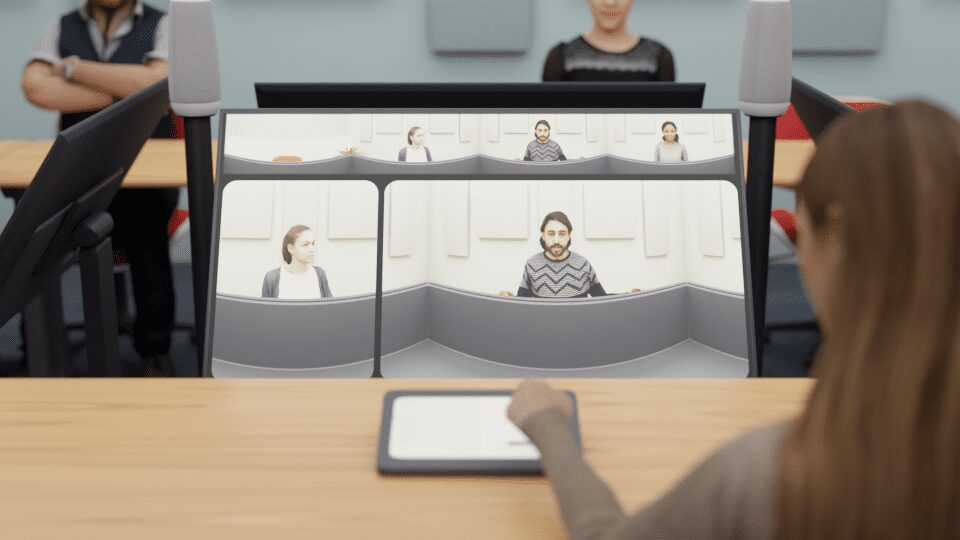Summary:
- Remote workers often have equal or even higher productivity levels than in-office workers, benefiting from reduced distractions and no commuting.
- While remote work can lead to feelings of isolation, strategies like regular check-ins, virtual team-building, and hybrid meeting solutions can combat this.
- Security concerns in remote work can be addressed through tools like VPNs, regular cybersecurity training, Multi-Factor Authentication, and endpoint security.
- The world of work is transitioning, with hybrid and remote work becoming standard in many industries. Organizations should take a proactive approach and invest in the right technology to help them reap the benefits.
- Hybrid work technology can improve collaboration, increase productivity, provide cost savings, and attract a wider talent pool. Contact ET Group to learn more about how to make the transition for your workplace.
Modern workplaces continue to evolve, but so do certain misconceptions about hybrid and remote work. When left unaddressed, these misconceptions can deter organizations from making the leap to more flexible and productive hybrid work environments.
Fortunately, our team at ET Group is well-versed in the truths and myths surrounding hybrid and remote work, and we’re here to help you understand the difference so you can make confident choices about upgrading your technology and providing a better experience for all of your team members. Join us below as we tackle three particularly major misconceptions regarding productivity, loneliness, and security.

Remote Work & Productivity
The Myth
One of the most prevalent myths surrounding remote work is that it leads to reduced productivity. The concern is that without the direct oversight of management and the structured environment of an office, employees tend to slack off.
The Reality
Contrary to this belief, numerous studies have found that remote workers often have equal or even higher productivity levels than their in-office counterparts. For instance, productivity among workers who shifted to remote work during the COVID-19 pandemic actually increased by 47% compared to the previous year’s metrics.
Why is this the case? Many remote workers benefit from:
- Reduced distractions
- No commuting times
- The flexibility to design their work environment in a way that best suits their productivity needs
These benefits can be experienced even further by creating custom hybrid spaces where your remote team members can collaborate seamlessly with your on-site personnel, ensuring the flow of ideas and tasks are uninterrupted.
Employee Isolation & Loneliness
The Myth
Another myth posits that remote work leads to employee isolation and loneliness, considering workers are physically removed from their colleagues.
The Reality
While the risk of feeling isolated exists, proactive strategies can effectively combat this challenge. Here’s how:
- Regular Check-ins: Managers can schedule regular check-ins to discuss not just work but also personal well-being. These one-on-ones can foster a closer bond between the employee and the organization.
- Virtual Team Building: From virtual coffee breaks to online team games, there are myriad ways teams can stay connected and engaged.
- Hybrid Meeting Solutions: Investing in advanced audiovisual technology can help make virtual meetings as interactive and engaging as in-person ones. Tools that facilitate real-time collaboration, screen sharing, and high-definition video conferencing can bridge the gap between remote and on-site team members.
See Also: Designing Conference Rooms that Work For Today’s Offices
Security & Confidentiality Issues
The Myth
Many businesses fear that allowing employees to work remotely can compromise the security and confidentiality of company data.
The Reality
What many organizational leaders don’t realize is that hacking and malware account for far fewer breaches than simple human error (which remains the top cause). So while security concerns are certainly legitimate, businesses can still ensure a high level of data security by implementing a few key tools and strategies:
- VPN & Encrypted Connections: Using Virtual Private Networks (VPNs) and ensuring encrypted connections can provide a secure online environment for remote workers.
- Regular Training: Employees should be regularly trained on cybersecurity best practices. This includes recognizing phishing attempts, securing their home networks, and following proper protocol when accessing company data.
- Multi-Factor Authentication (MFA): MFA adds an extra layer of security by requiring multiple forms of verification before granting access.
- Endpoint Security: Ensuring that all devices, including personal ones used for work, have the latest security patches and anti-malware software installed.
Collaboration & Innovation
The Myth
Another common myth around the hybrid work model is that it hampers collaboration and stifles innovation. The fear is that the creative energy generated through in-person interactions will be lost when teams are distributed across different locations.
The Reality
While it’s true that in-person interactions can sometimes support spontaneous and valuable collaborations, the notion that hybrid work inherently stifles innovation is incorrect. In fact, a well-managed hybrid environment actually promotes creativity and collaboration. Here’s how:
- Flexible Brainstorming: Hybrid work models offer the flexibility to schedule focused, in-person brainstorming sessions when needed, while still allowing individual team members the freedom to work remotely for tasks that require deep concentration.
- Diverse Perspectives: Remote work often means a more diverse workforce, as companies can tap into talent pools that aren’t geographically limited. A team with diverse experiences and viewpoints can enrich creativity and contribute to more innovative solutions.
- Digital Tools for Collaboration: A wide array of collaboration tools like Slack, Microsoft Teams, and Google Workspace offer features for real-time collaborative work, from text and video chats to digital whiteboarding.
- Time-Shifted Collaboration: In a remote or hybrid work environment, not all team members need to be online at the same time to collaborate. The asynchronous nature of many digital tools allows for “time-shifted” collaboration, which can actually improve the quality of input and feedback.
Company Culture
The Myth
Another misconception surrounding the hybrid work model is that it erodes organizational culture. Some believe that without daily physical interactions, the shared values, rituals, and practices that make up a company’s culture can start to fade away.
The Reality
The building blocks of organizational culture are not restricted to a physical location. While it may be challenging to replicate the “water cooler” moments of an office environment, a strong culture can be nurtured in a number of different ways:
- Virtual Team-Building: Regularly scheduled virtual events such as game days, happy hours, or team lunches can help reinforce your team’s sense of unity and shared purpose.
- Clear Communication: Transparent two-way communication from leadership about your company’s goals, values, and milestones can help build a cohesive culture, even when the workforce is scattered.
- Shared Digital Spaces: Platforms that serve as an online “office” can host team updates, achievements, and even casual chat rooms that resemble office encounters. Well-designed hybrid spaces will be essential for supporting company culture as more organizations embrace remote work.
- Cultural Ambassadors: Designate team members as ‘cultural ambassadors’ who are tasked with maintaining team cohesion and culture. They can be pivotal in organizing virtual team-building activities and ensuring that new members assimilate into the existing culture efficiently.
Adapting As the World Embraces Hybrid & Remote Work
The world of work is undergoing a significant transformation—so the question isn’t whether you should adapt; it’s how you’ll need to in order to keep thriving. Organizations that are willing to move past misconceptions and invest in the right technology will find themselves better poised to harness the benefits of hybrid and remote work as it becomes the new standard for an increasing number of industries.
The key is to understand what legitimate challenges exist when pivoting towards hybrid work, and what concerns are unfounded. Learn more about how to transition to a hybrid work environment effectively by contacting our team at ET Group, or browse the FAQ below.
Frequently Asked Questions about Hybrid & Remote Work
What specific benefits can hybrid work technology bring to my organization?
Hybrid work technology offers a wide range of benefits to businesses to embrace its possibilities, including:
- Improved Collaboration: Hybrid work technology fosters better collaboration between remote and on-site team members.
- Increased Productivity: This enhanced collaboration often leads to heightened productivity levels.
- Cost Savings: Organizations can experience savings related to real estate and utilities.
- Attracting Talent: The flexibility offered by hybrid models can attract a broader range of talent who prioritize flexible work options.
Are there any hidden costs to consider when transitioning to a hybrid work model?
Apart from the apparent technology and training investments, organizations might face costs related to:
- Changing company culture
- Technology maintenance
- Software subscription renewals
However, many of these are offset by the long-term savings and benefits hybrid work offers.
What steps should my organization take to prepare its workforce for the transition to hybrid technology?
Key steps include:
- Communicating the reasons behind the change
- Providing ample training opportunities
- Gathering feedback during the transition
- Being open to iterative improvements based on challenges faced
Consider additional training to help your team acclimate as you move towards a hybrid model. ET Group’s workshops can provide your organization with tools and strategies designed to reduce friction during this process.
How can my organization address concerns about hybrid technology?
Open communication is key. Address concerns by presenting data on the benefits, involving employees in the decision-making process, and providing platforms for feedback. Moreover, pilot programs can be launched to test and showcase the effectiveness of the technology.
See Also: Managing Your Hybrid & Remote Workers
Are there any industries where hybrid or remote work isn’t feasible?
While many industries can adopt hybrid models, some roles, especially those requiring specialized equipment or hands-on tasks (e.g., healthcare or manufacturing), might still find it challenging. However, as automation and audiovisual technology both become more advanced, a growing number of industries are likely to support hybrid work, so it’s always worth considering how you can become an early adopter and stay ahead of the curve.
Stay connected with us:
Follow ET Group on LinkedIn
Follow us on Twitter
Subscribe to ET Group’s YouTube Channel











